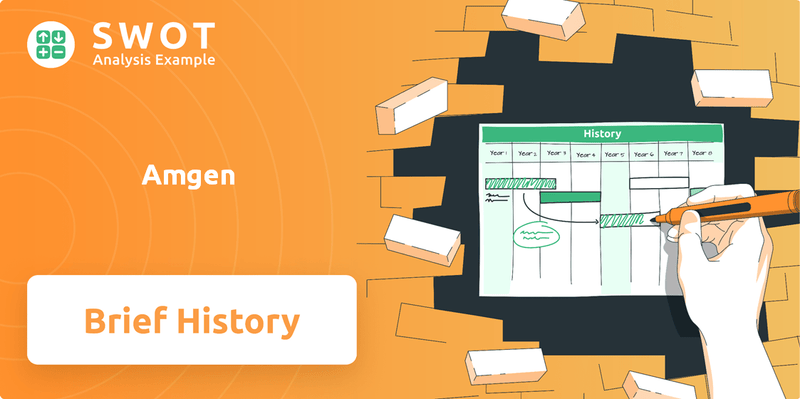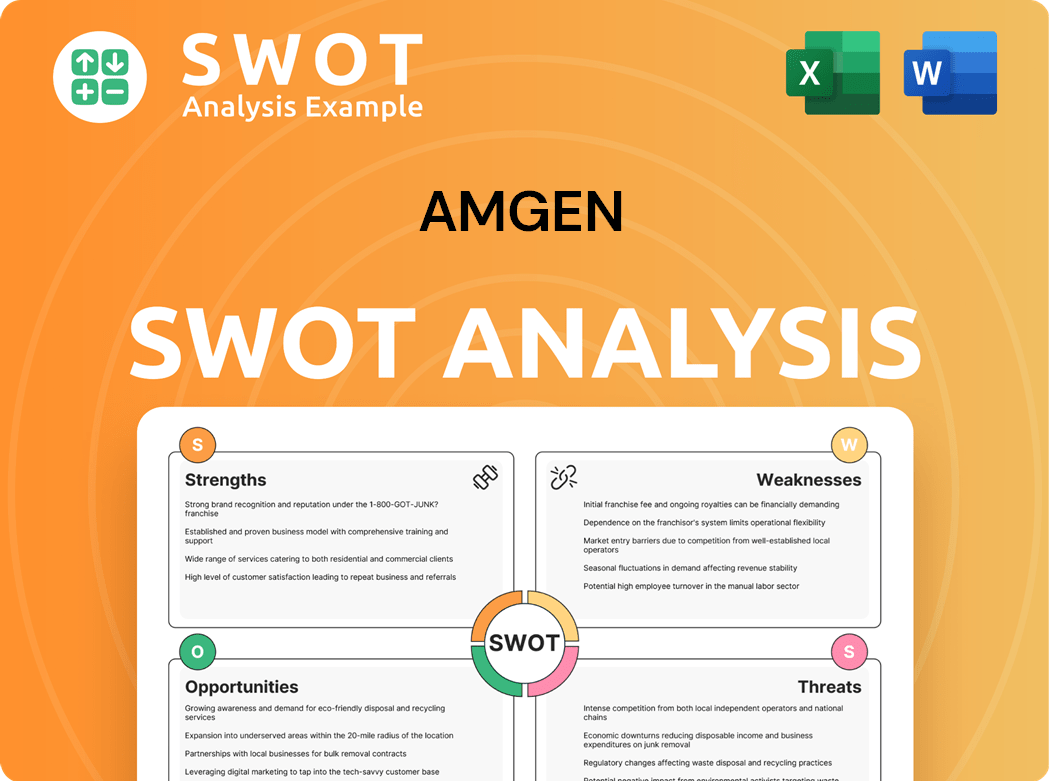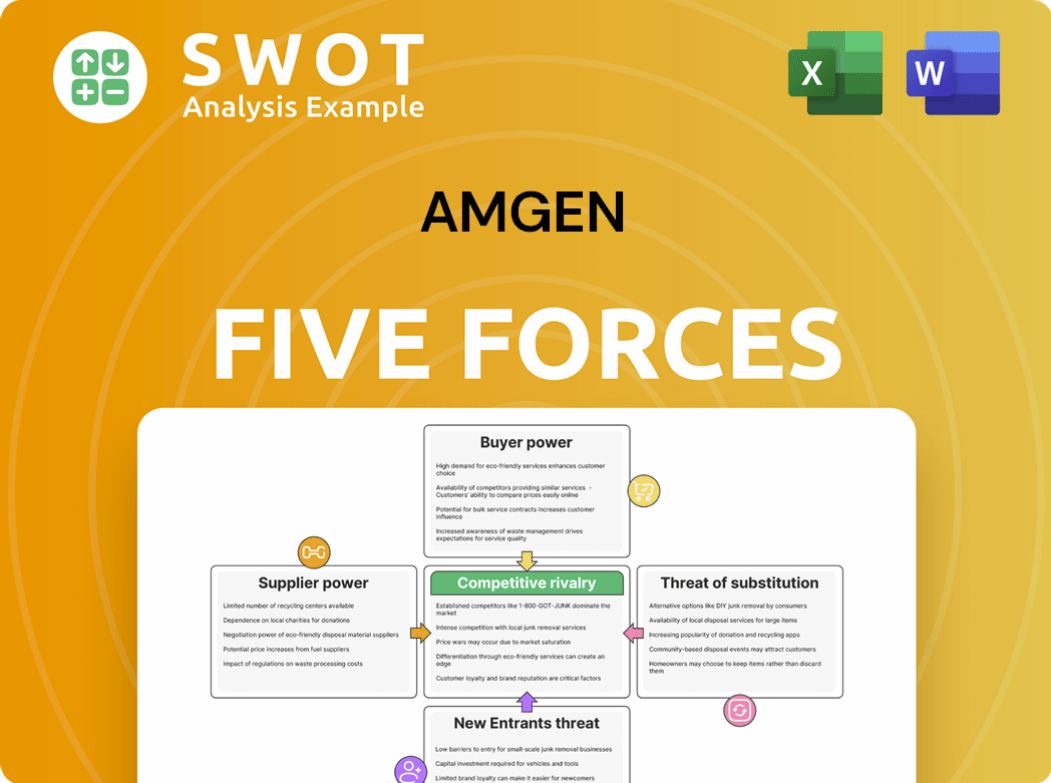Amgen Bundle
How Did Amgen Revolutionize Biotechnology?
Founded in 1980 in Thousand Oaks, California, Amgen, originally known as Applied Molecular Genetics Inc., embarked on a mission to transform medicine through biotechnology. This ambitious vision propelled the company to the forefront of the pharmaceuticals industry, focusing on innovative human therapeutics. From its inception, Amgen has been a pioneer, developing groundbreaking biologics that have reshaped the treatment landscape.

Amgen's journey from a small startup to a global biotechnology leader is a testament to its unwavering commitment to research and development. With approximately 28,000 employees and operations spanning roughly 100 countries as of 2024, Amgen's impact is undeniable. To understand the strategic decisions that fueled this growth, explore the Amgen SWOT Analysis to understand the company's strengths, weaknesses, opportunities, and threats within the competitive landscape of the pharmaceuticals industry.
What is the Amgen Founding Story?
The story of Amgen, a leading player in the biotechnology and pharmaceuticals industry, began in Thousand Oaks, California. This journey started with a vision to harness the power of genetic engineering for developing innovative therapeutics.
Understanding the brief history of Amgen provides insights into its evolution from a startup to a global pharmaceutical powerhouse. The company's early focus and strategic decisions laid the groundwork for its future success.
The company's story is a testament to the power of innovation and strategic foresight in the biotechnology sector. Let's delve into the founding story of this remarkable company.
Amgen, originally named Applied Molecular Genetics Inc., was officially established on April 8, 1980, in Thousand Oaks, California. The company was the brainchild of venture capitalists William K. (Bill) Bowes and his associates, along with George B. Rathmann, who became the first president and CEO in October 1980. Gordon M. Binder, another venture capitalist, was also a key co-founder. The founders recognized the potential of genetic engineering to create new therapeutics, a shift from the small-molecule drugs common at the time.
- Amgen's initial focus was broad, exploring various biotechnology applications.
- The company's name, a portmanteau of 'Applied Molecular Genetics,' became official in 1983.
- The initial funding came from venture capitalists, with a significant boost from its IPO on June 17, 1983, which raised nearly $40 million.
- The early 1980s, with advancements in recombinant DNA technology, provided a favorable environment for companies like Amgen.
The early days of Amgen were marked by a broad exploration of biotechnology applications. Scientists at the company investigated diverse projects, including developing organisms for oil extraction from shale, accelerating chicken growth, and producing indigo dye in E. coli. However, the company's strategic direction ultimately crystallized around treating and curing human diseases. This shift was crucial in shaping Amgen's future as a pharmaceutical leader.
The initial funding for Amgen came from a small group of venture capitalists who saw the potential in the emerging field of biotechnology. A pivotal moment was the Initial Public Offering (IPO) on June 17, 1983. This IPO raised nearly $40 million, providing the necessary capital for Amgen's ambitious research and development programs. This financial injection was critical for the company's early growth and its ability to pursue groundbreaking scientific endeavors.
The early 1980s provided a fertile ground for biotechnology companies like Amgen. The advancements in recombinant DNA technology created opportunities for innovation and growth. This environment allowed Amgen to emerge and pursue groundbreaking biological research, setting the stage for its future achievements. For more insights, read about the Growth Strategy of Amgen.
Amgen SWOT Analysis
- Complete SWOT Breakdown
- Fully Customizable
- Editable in Excel & Word
- Professional Formatting
- Investor-Ready Format

What Drove the Early Growth of Amgen?
The early growth of the Amgen company was characterized by significant scientific advancements and strategic expansion. These early moves laid the groundwork for its future success in the biotechnology and pharmaceuticals industries. This period saw the company establish itself as a pioneer in the field, achieving several key milestones that shaped its trajectory.
A pivotal moment in the Amgen history came in 1983 when a research team successfully cloned the human erythropoietin (EPO) gene. This led to the development of Epogen (epoetin alfa). This achievement was a major turning point for the company.
Epogen became the first biotechnology product to receive FDA approval in 1989. This was a major milestone for Amgen and the biotechnology industry. In February 1991, Amgen received FDA approval for Neupogen (filgrastim).
By 1992, Amgen's combined product sales for Epogen and Neupogen reached $1 billion. The company was added to the S&P 500 and debuted on the Fortune 500 list. These financial achievements highlighted Amgen's rapid growth.
Amgen began its international presence in 1989. In March 1993, the company opened a new manufacturing facility in Puerto Rico. By the mid-1990s, Amgen's global workforce had grown to over 3,400 employees, demonstrating its expanding global footprint.
Amgen PESTLE Analysis
- Covers All 6 PESTLE Categories
- No Research Needed – Save Hours of Work
- Built by Experts, Trusted by Consultants
- Instant Download, Ready to Use
- 100% Editable, Fully Customizable

What are the key Milestones in Amgen history?
The Amgen company, a leader in the biotechnology industry, has a rich Amgen history marked by significant achievements. From its early days in Thousand Oaks to its current global presence, Amgen has consistently pushed the boundaries of medical innovation. Its journey is a testament to the power of strategic vision and dedication to scientific advancement.
| Year | Milestone |
|---|---|
| 1989 | Approval of Epogen, a groundbreaking treatment for anemia. |
| 1991 | Launch of Neupogen, a therapy to boost white blood cell production. |
| 2001 | Introduction of Aranesp, an improved treatment for anemia. |
| 2002 | Release of Neulasta, a drug to reduce infection risk during chemotherapy. |
| 2004 | Launch of Sensipar, a treatment for secondary hyperparathyroidism. |
| 2010 | FDA approval of Prolia, a medication for bone health. |
| 2015 | Development of the first innovative medicine for cardiovascular disease. |
| 2023 | Acquisition of Horizon Therapeutics, expanding into rare diseases. |
| 2024 | Launch of Wezlana (biosimilar for Stelara) and Pavblu (Eylea biosimilar). |
| 2025 | FDA approval of UPLIZNA for IgG4-related disease (April 2025). |
Amgen has consistently been at the forefront of innovation in the pharmaceuticals sector. The company's commitment to research and development has led to a robust pipeline of first-in-class and best-in-class therapeutics.
Amgen pioneered the development of recombinant protein-based therapies, including Epogen and Neupogen. These innovations transformed the treatment of various diseases and set a new standard in the industry.
Amgen has made significant strides in developing innovative medicines for cardiovascular diseases. These treatments address critical health needs and contribute to improved patient outcomes.
Amgen is actively developing biosimilars to increase access to important medications. Launches like Wezlana and Pavblu, along with plans for Bkemv, demonstrate Amgen's commitment to this area.
The launch of IMDELLTRA, a recent innovation, generated $81 million in sales in Q1 2025. This showcases Amgen's ability to bring new, effective treatments to market.
The FDA approval of UPLIZNA in April 2025 as the first treatment for IgG4-related disease highlights Amgen's focus on addressing unmet medical needs. This approval underscores the company's dedication to innovation.
Amgen is leveraging advanced data analytics and AI to accelerate research and time to market. This strategic approach enhances the efficiency of drug development.
Despite its successes, Amgen has faced several challenges throughout its history. These include high drug development costs, regulatory complexities, and intense competition from other major pharmaceutical companies.
Developing new drugs is expensive and carries significant risks. Amgen invests heavily in R&D, but not all projects succeed, impacting profitability.
Navigating the regulatory landscape is a constant challenge for Amgen. Securing approvals from agencies like the FDA is a complex and time-consuming process.
Amgen faces strong competition from other major pharmaceutical companies, such as Roche, Pfizer, and Johnson & Johnson. This competition impacts market share and pricing.
The looming threat of patent losses for key products, such as Otezla and Enbrel, which combined for over $1.6 billion in Q4 2024 sales, poses a significant financial risk.
Amgen, like other companies, is susceptible to market downturns. Economic fluctuations can affect sales and investor confidence.
Amgen has strategically repositioned itself by focusing on acquisitions like Horizon Therapeutics in 2023. This expansion into the rare disease market is a key strategy.
Amgen Business Model Canvas
- Complete 9-Block Business Model Canvas
- Effortlessly Communicate Your Business Strategy
- Investor-Ready BMC Format
- 100% Editable and Customizable
- Clear and Structured Layout

What is the Timeline of Key Events for Amgen?
The Amgen company has a rich history, marked by significant milestones in the biotechnology and pharmaceuticals industries. Founded in Thousand Oaks, California, in April 1980, it quickly became a pioneer in the field. From its initial public offering in 1983 to its expansion through acquisitions and product approvals, Amgen has consistently pushed the boundaries of scientific innovation.
| Year | Key Event |
|---|---|
| April 8, 1980 | Amgen (Applied Molecular Genetics Inc.) is founded in Thousand Oaks, California. |
| October 1980 | George B. Rathmann is named the first CEO. |
| June 17, 1983 | Amgen goes public, raising nearly $40 million, and officially changes its name to Amgen. |
| 1983 | Amgen researchers clone the human erythropoietin (EPO) gene. |
| 1985 | Amgen genetically engineers granulocyte colony-stimulating factor (G-CSF). |
| October 1988 | Gordon Binder is appointed CEO. |
| 1989 | FDA approves Epogen (epoetin alfa), Amgen's first product. |
| February 1991 | FDA approves Neupogen (filgrastim). |
| 1992 | Amgen achieves $1 billion in combined product sales for Epogen and Neupogen. |
| March 1993 | Amgen opens a manufacturing facility in Puerto Rico. |
| 2002 | Amgen acquires Immunex, marking its entry into inflammatory diseases. |
| June 2010 | FDA approves Prolia (denosumab) for post-menopausal osteoporosis. |
| November 2010 | FDA approves Xgeva for prevention of bone metastases complications. |
| 2023 | Amgen completes its largest acquisition to date, Horizon Therapeutics, expanding into rare diseases. |
| February 4, 2025 | Amgen reports full-year 2024 total revenues of $33.4 billion, a 19% increase from 2023. |
| April 25, 2025 | Amgen announces a $900 million manufacturing expansion in Ohio, creating 350 new jobs. |
| May 1, 2025 | Amgen reports Q1 2025 total revenues of $8.1 billion, a 9% increase from Q1 2024. |
Amgen's strategic plans through 2030 focus on innovation and global patient reach. The company is investing heavily in its pipeline across cancer, heart disease, osteoporosis, inflammatory diseases, and rare diseases. They anticipate 2025 total revenues to be between $34.3 billion and $35.7 billion.
A key area of future growth is the biosimilars market. Amgen expects biosimilar sales to reach $4 billion by the end of the decade. This expansion is a significant part of Amgen's strategy to provide more affordable and accessible medicines.
Amgen is advancing its investigational obesity treatment, MariTide, into pivotal Phase 3 clinical trials in March 2025. The monthly dosing schedule of MariTide could be a significant differentiator in the competitive obesity drug market.
Amgen is exploring opportunities in digital health integration to enhance patient care and treatment adherence. This approach aligns with the company's long-term vision of transforming science and biotechnology into therapies that restore health or save lives.
Amgen Porter's Five Forces Analysis
- Covers All 5 Competitive Forces in Detail
- Structured for Consultants, Students, and Founders
- 100% Editable in Microsoft Word & Excel
- Instant Digital Download – Use Immediately
- Compatible with Mac & PC – Fully Unlocked

Related Blogs
- What is Competitive Landscape of Amgen Company?
- What is Growth Strategy and Future Prospects of Amgen Company?
- How Does Amgen Company Work?
- What is Sales and Marketing Strategy of Amgen Company?
- What is Brief History of Amgen Company?
- Who Owns Amgen Company?
- What is Customer Demographics and Target Market of Amgen Company?
Disclaimer
All information, articles, and product details provided on this website are for general informational and educational purposes only. We do not claim any ownership over, nor do we intend to infringe upon, any trademarks, copyrights, logos, brand names, or other intellectual property mentioned or depicted on this site. Such intellectual property remains the property of its respective owners, and any references here are made solely for identification or informational purposes, without implying any affiliation, endorsement, or partnership.
We make no representations or warranties, express or implied, regarding the accuracy, completeness, or suitability of any content or products presented. Nothing on this website should be construed as legal, tax, investment, financial, medical, or other professional advice. In addition, no part of this site—including articles or product references—constitutes a solicitation, recommendation, endorsement, advertisement, or offer to buy or sell any securities, franchises, or other financial instruments, particularly in jurisdictions where such activity would be unlawful.
All content is of a general nature and may not address the specific circumstances of any individual or entity. It is not a substitute for professional advice or services. Any actions you take based on the information provided here are strictly at your own risk. You accept full responsibility for any decisions or outcomes arising from your use of this website and agree to release us from any liability in connection with your use of, or reliance upon, the content or products found herein.